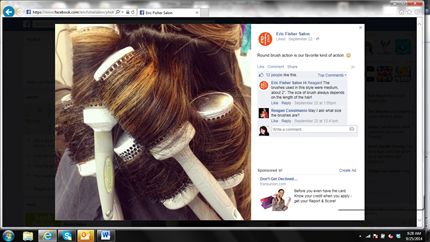The Four Phases of Retail Sales
One of the biggest incomes for a salon comes from selling retail. But often, clients leave without any product purchases. According to Eric Fisher, owner of award winning, Eric Fisher Salons & Academy in Wichita, KS, “The average client has 19 beauty products in their bathroom. People love to buy, but hate to be sold.” In his best-seller, Source Book – A Complete Training Program from Cutting to Culture, he provides guidelines, scripts and systems to manage every step of the client experience.
Retailing represents a consistent and strong source of revenue in your salon. Training stylists to use and demonstrate their knowledge on products is the foundation of retail success. When a stylist “shares their knowledge” about the product being used with confidence and uses easy to understand language, this sets up the perfect opportunity for increased retail sales.
According to Eric, there are four phases during the salon experience where you can plant the seed of buying in the minds of your clients. During each phase, a stylist should use the following tips to set the stage for the retail sale upon completion of the service.
Phase 1: Priming. This phase takes place during shampooing and conditioning. Based on the client’s hair type and product selection, share the information on why you’re using that product. For example: “I’m using this shampoo (state the name) because it will help add fullness and volume.” Or, “I’m using this conditioner (state the name) because it will help strengthen and moisturize your dry, distressed hair making it soft and silky.”

Phase 2: Styling. As you apply a styling product to wet hair, explain where the product goes and what it’s going to do. For example: “To blow-dry your hair and give it smoothness, I’m applying this product (state the name) from scalp to ends to give us control.” Show them what tools to use and how to use them. If a client does not have all the tools you would find in a salon, give them examples of what they can use at home, such as Velcro rollers. This is an important part of your service. Teach them how to recreate the look at home. This will keep them very happy as a client and loyal for life!
Phase 3: Texturizing. Explain to your client and clearly show them how to use these products. Explain that they are placed on finished hair to add texture, separation or to add interesting shape and movement to the look. Show them how to emulsify in your fingers and then gently, rub and smooth through sections where you want to add the effect. Teach them how to use the product.
Phase 4: Finishing. If the look requires it, demonstrate how to apply products placed or sprayed on the finished style to add shine or holding power. With a hair spray, explain the proper distance and amount of spray to use. With a shine mist product, explain how lightly and little they need to make the hair glossy.
After you have completed the service, always hand the client a mirror, so she can fully examine the finished style. Make sure to tell her that the retail products used to create the look come with a 100 percent money back guarantee, so if she does not like them, they can be returned.
Let your clients know you stand behind your work and the products by saying, “If you have any challenges with your style, color, or products, please call me, and I’ll take care of you right away.” This type of encouragement takes the risk out of buying products and demonstrates that you want them to be completely satisfied and happy with the service and products you provided.
Finally, as they are checking out at the front desk, get the products in their hands. Facts speak for themselves. According to Eric, if you hand them:
One product, there is a 50% chance of a sale.
Two products, there is a 76% chance of a sale of one.
Three products, there is an 83% chance of a sale of one.
Four products, there is a 47% chance of the sale of one.
Retail sales will not only happen, but they will increase dramatically when stylists engage clients in what they are using every step of the way during the salon experience. For more business building tips on retailing, front desk management, team building, motivating staff, how to manage complaints, and create a culture of quality and excellence, look for Eric Fisher’s books in the BTC Bookstore today!
More from
Eric Fisher
-
Business
12 Ways to Run a Better Business
-
Business
4 Steps to Bring Clients Back with Eric Fisher
-
Business
3 Promotions to Warm Up February and March
-
Business
5 Core Values for Salon Success
-
Business
3 Tips for Better Customer Service in 2016!
-
Business
6 Ways Events Can Boost Your Business
-
Business
6 Steps To Increase Pre-Booking








